CHAPTER 27
THE DIVING INVESTIGATION
01.-04.12.94
From 1st to
4th December 1994 the wreck was examined by divers from Rockwater A/S Stavanger
and by ROVs from Smit Tak, Rotterdam (parent company of Rockwater A/S) apparently
contracted by the Swedish Sjöfarts-verket. The divers were working out of
diving bells from the diving support vessel SEMI I. Börje Stenström, member
of the Swedish part and head of the technical group, was said to have been
the only member of the JAIC on board. In addition, there were on board Arne
Valgma, head of the Estonian Ship Safety Division of the E.N.M.B., Ulf Hobro
from Nordström & Thulin, the responsible director Johan Fransson and the operations
manager Åke Vide from Sjöfartsverket, a number of Swedish criminal police
officers, one English salvage expert and the Swedish diving expert Gustav
Hanuliak, both on behalf of Sjöfartsverket, as well as some persons unidentified
so far.
Note: It
is doubtful whether Börje Stenström was the only JAIC representative on
board as it would be against the general attitude of the Finns demonstrated
before and after the diving investigation, namely to be represented by their
own people whenever relevant parts of the investigation were carried out.
Since the diving investigation of the wreck was the most relevant part of
the investigation so far, it has to be assumed that Finland was represented
by Tuomo Karppinen, as testified by Arne Valgma who attended on board.
This assumption is shared by the then chairman of the JAIC, Andi Meister,
in his book "The Unfinished Logbook", where he states that the Estonian
participant Arne Valgma shared his monitor cabin with Tuomo Karppinen from
the Finnish part of JAIC. According to Andi Meister this was subsequently
denied by the Finns who - for understandable reasons - did not want to take
over part of the responsibility for the occurrences on board of the diving
platform SEMI 1 such as the wilful manipulation and deletion of essential
evidence in which Mr. Karppinen most likely participated.
The main purpose
of the diving operation, which was paid by the Swedish Government, was to
establish:
(a) Could the
ESTONIA be lifted up as a whole?
(b) How many
bodies could be recovered without lifting the vessel, and
(c) would
it be possible to cover the ESTONIA with stones/concrete?
The results are
outlined in two official reports available to the public, viz.
- Condition
Survey of the vessel ESTONIA for the Swedish National Maritime Administration
by Rockwater A/S, Stavanger (attached as Enclosure
27.409), and
- Survey Report M.V. ESTONIA dated 08.12.94 by Smit Tak B.V., Rotterdam
(attached as Enclosure
27.410).
In addition, the
divers had to inspect and record on video tapes the foreship area as well
as the navigation bridge on behalf of the JAIC and according to the instructions
of Börje Stenström and/or Tuomo Karppinen.
According to
the Rockwater Report to Sjöfartsverket the underwater work was documented
on 19 video tapes which were handed over to Sjöfartsverket/Swedish criminal
police before they left the diving platform by helicopter. Allegedly Rockwater
kept only those videos on which the safety of the divers was documented, in
case health problems should appear, which was not the case. Those videos allegedly
were destroyed one week after the last diver entered the bell.
At a subsequent
meeting in Helsinki on 02.10.96 between the JAIC and the Rockwater representatives
Ray Honour, managing director / Dave Cawson, project manager / Terry Jost,
diver (one of the two divers having examined the bridge) the following was
established:
»Whatever the
divers did was documented in detail by Rockwater in three different logbooks.
It is possible to check each individual episode by comparing the entries
in the logbooks with the video logs respectively with the videos themselves.
It can be excluded that sequences have been removed from the videos. On
some tapes date and times are recorded, on others not because the input
had to be made in the operation room which was not done with all tapes.
The conditions were very difficult, the visibility was poor, each movement
caused a cloud of settled-down sediments.«
The diving operation
was performed by four teams of three divers who worked around the clock from
two diving bells hanging next to the wreck. The first diver of the team remained
in the bell, the other two proceeded to the designated area where one did
the work according to instructions from the supervisor in the operation room
while the other secured him by checking his umbilical, etc. The divers worked
in diving suits with helmets, which were connected by the said umbilical containing
all the necessary supply and communication lines to the diving bell respectively
to the diving platform. On top of the helmets one searchlight and one, probably
two, video cameras were mounted. The diver received his instructions through
two earphones - one in each ear - and spoke into one microphone. On the video
tapes available to the public only the voice of the supervisor into one of
the earphones and the voice of the diver are audible. Only on some occasions
does it become evident that the diver gets additional respectively other instructions
when he reacts differently or replies differently, this being particularly
obvious when he quickly turns his head away from areas which the public should
not see as will be explained on the following pages. It is common practice
- according to the diving expert Brian Braidwood - that divers carry two different
earphones during an operation like the one under consider-ation here.
The following pictures
show two of the Rockwater divers with diving suit, helmets and umbilical.

Due to being 100%
supplied and disposed off via the umbilical these divers do not create air
bubbles in the water.
The video films
were produced in the PAL format by the cameras on the helmets of the divers.
From these
films the following are available to this 'Group of Experts':
|
Tape
no.
|
Tape
name
|
Contents
|
Time
|
| 6 |
B40a |
Bulbous
bow with audio |
0.14.19 |
| 7 |
B40b |
ROV
hull survey and bow area |
2.56.03 |
| 8 |
B40c |
Divers
survey mainly bow |
3.00.00 |
| 9 |
B40d |
Nav
bridge survey |
3.03.57
|
| 10 |
B40e |
Around
the bow and then on nav bridge |
2.41.29 |
| 11 |
ROV19/06/96 |
Good
quality all over, but cut and various dates |
2.03.49 |
| 12 |
ROV
Sprint 3/12/94 = other |
|
|
| 13 |
ROV
mudline no date |
Stern,
prop, hull survey, bow thruster, etc. |
1.53.44 |
| 18 |
ROV
9/10/94-Sprint 3/12/94-diver |
Good
quality all sorts sprint 3/12/94 diver |
|
| 19 |
B40c
RW/SEMi1/EST/ D/013007 |
Divers
deck no1 & bow investigation |
3.00.00 |
| 20 |
B40b
Sprint/94/Estonia/ 01001-006 |
ROV
Hull survey |
2.56.00 |
Also these films
were handed over to the video experts of Disengage/UK for analysis and evaluation
- see Subchapter 34.6.
One of the
results was that - except videos 11 and 18 - all other video films - although
made in the PAL format - had been copied by a PAL/SECAM machine without a
converter in between. This results in poor copies, which are much too light
and unclear - a fact which makes a proper evaluation of the video material
very difficult, sometimes impossible. In addition, relevant parts had been
cut out of these videos as will also be demonstrated in Subchapter 34.6.
These videos
were and still are being copied in Sweden by a private company called "FORSVARSMEDIA"
which is said to work exclusively for the Ministry of Defence, and as such
has security clearance. Reportedly Börje Stenström had decided before any
copying was done which parts should be hidden from the public and cut out.
These concern footage showing the hull above the starboard mudline including
the starboard stabiliser and certain areas of the foreship and the bodies
inside the wreck and on the bridge.
While the video
sequences showing undesired parts of the wreck were deleted - which fact has
led to the discrepancies in the timing as shown by Disengage (see Subchapter
34.6) - the bodies have been made invisible by light spots, also the three
"official" bodies on the bridge. Even though it is stated in the Rockwater
Report, among other things: »The bodies on the bridge showed signs of decomposition,
but were also undamaged.«, and the Sjöfartsverket Report added: »On the bridge,
where many windows were missing, one body had been attacked by fish.«, the
bodies on the bridge were allegedly not identified by their uniforms. This
was explained by Börje Stenström, as follows:
»The divers
did not know any of the victims personally. So, how could they identify
them?«
Note: By
the stripes on their uniforms, as it had initially been assumed that all victims
were officers.
This is most annoying,
because the question who was on the bridge during the final minutes is of
importance, in particular, whether the master was there.
From the distress
communication it is known that the watch officer - 2nd mate Tormi Ainsalu
- the 3rd mate Andres Tammes and most probably also chief officer Juhan Herma
- had been on the bridge until 01.30 hours - the end of the 'Mayday' communication
- see Subchapter 22.1 - when the vessel was practically on the side. Of these
three Ainsalu and Tammes were seen by Sillaste to leave the bridge, while
Herma apparently remained inside. According to 3rd engineer Margus Treu, he
was asked by 4th mate Kaimar Kikas at a rather late stage after the diesel
generators had already shut down, whether he could pump freshwater overboard
from the starboard tanks. Thus it could be assumed that the 4th mate also
stayed in the bridge. The third body should be the master according to the
"evidence" of watch A.B. Silver Linde, which in all probability is wrong because
he had not been back to the bridge before, at or after 01.00 hours - see Subchapter
21.2.2. Nevertheless, the crew survivors were very certain from the beginning
that Captain Andresson had died on the bridge, which is not surprising because
it has to be assumed with certainty that at least one of the surviving officers/engineers
had been on the bridge after the big heel and seen what had happened.
In summary this
would explain the three bodies as found by the divers, viz.
1) close to the
door leading out to the aft on port side, across the door leading to the
inside stairway.
2) inside
the chart room without further details.
3) in the
starboard wing below the broken loose flagbox.
The above is revealed
from the voice communication between two divers and the supervisors on board
the SEMI 1 according to video tapes B40c and B40d which are available and
from the Finnish report of the JAIC, page 131. In addition, more information
about the bodies became publicly known partly through the Andi Meister book
"The Unfinished Logbook" and partly through the Estonian media. These are:
- the body at
the aft port door was wearing a brown or red/brown suit.
- the body
underneath the flagbox in the starboard bridge wing had a tattoo on his
right hand.
Reportedly neither
Captain Andresson nor Juhan Herma nor Kaimar Kikas had a tattoo on their right
hand and certainly none of them was wearing a brown or red/brown suit. So,
who are the three bodies on the bridge and where does this information come
from?
On the other hand,
the detailed knowledge of the Estonians about the condition of the bodies
inside the bridge indicates that they had been there with own divers. Furthermore,
neither the descriptions above nor the few words of the divers audible on
the videos indicate that any of these bodies was badly decomposed and/or had
been attacked by fish.
The explanation
for this discrepancy was discovered by Disengage when analysing the available
footage frame by frame. They found out that the first diver inspecting the
bridge - Dave Mawston - before entering the port bridge wing through the lower
aft window, which was already broken, cleared away the glass remains and mashwire
and then pulled out a body by the hair to the outside where he let it go.
This body was only approximately half a body because the lower half was missing,
possibly due to having been attacked by fish or by being badly decomposed?
Whatever the cause for this terrible injury might have been, this body was
neither found near the port aft door nor in the chartroom nor in the starboard
wing below a flagbox; it was removed from the bridge before the first diver
entered the bridge and before the aforementioned three bodies were found.
Consequently there had been a fourth body on the bridge, the existence of
which is not mentioned by the Swedish participants. The evaluation of the
so-called "Mudline video", showing the starboard hull - and bottom area in
way of the mudline, revealed the existence of a fifth body just outside the
starboard bridge wing which is also nowhere mentioned. - See Subchapter 34.6.
Apparently the Swedes in the JAIC were also hiding these bodies from the only
Estonian participant of the diving investigation, Arne Valgma, who was said
to have been sleeping during the first inspection of the bridge, because he
had been told that nothing special would happen during the hours ahead. He
was interviewed on the subject by Spiegel TV, but the interview is not available.
The question remains:
Why didn't the Swedes onboard the SEMI 1 arrange for proper identification
of the bodies on the bridge and why do they keep secret the fourth and the
fifth body?
There were
several other incidents respectively observations during the diving survey
to which attention has to be drawn, viz.:
(1) The torn and
broken open underside of the starboard bridge wing.
(2) The inspection
of particular cabins on the 6th deck.
(3) The inspection
of the forward part of the 1st deck and the 0-deck.
(4) The ROV
"inspection" of the car deck and the consequences.
(5) The activities
of other divers with other equipment inside the car deck.
(6) The condition
of the rails and the preventer wires of the bow ramp.
(7) The angle
iron in the housing of the port bow ramp actuator.
(8) The condition
of the starboard stern ramp.
None of all
this is mentioned in the JAIC Report.
as to (1): The
torn and broken open underside of the port bridge wing.
The area in question
and the extent of this unusual damage at an unusual location shall be illustrated
by a number video images. The first ones were made from footage produced already
on 02.10.94, i.e. 4 days after the casualty, and the last ones at the diving
investigation between 01-04.12.94. The arrow on the picture below points to
the area in question.
No.
1 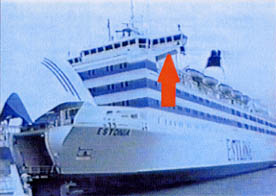
No
2, No 3 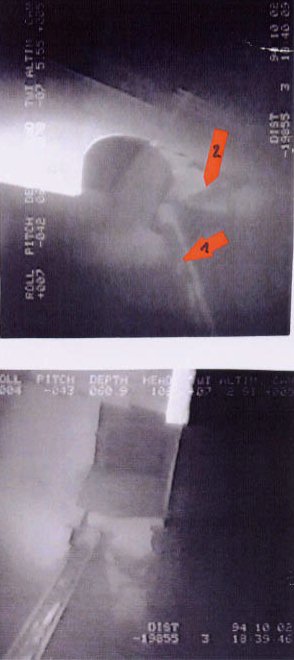
No 4, No
5
The images on the
previous pages are explained as follows:
No. 1 - The arrow
points to the area in question - the underside of the port bridge wing.
No. 2 - was made
on 02.10.94 and shows the aft part of the port bridge wing looking from
aft. The vertical stanchion, initially located vertically in line with the
aft plating of the wing, is visibly bent forward (arrow 1) together with
adjacent plating - arrow 2. The paint at the (port) outside of the stanchion
is completely scored off.
No. 3 - made on
02.10.94 and shows the same area from below with the stanchion and plating
pushed forward and a pulled down square looking like an access hatch which,
however, had not been there on delivery of the ship according to the drawings.
No. 4 - made during
the diving investigation on 03.12.94 and shows the plating of the underside
of the port bridge wing now completely torn off. The arrow points to the
window of the owners' cabin.
No. 5 - made on
03./04.12.94 shows the empty space between the bottom of the bridge and
the initial underside plating which is now missing.
It is quite obvious
that part of the damage did exist already on 02.10.94, i.e. 4 days after the
casualty when the first (official) ROV went down and that the damage was enlarged
during the time until the diving investigation of 01.-04.12.94. The damage
is not mentioned in either the Smit-Tak/Rockwater Reports nor in the Sjöfartsverket
or JAIC Reports and has also not been discussed by the media.
This damage
cannot be attributed to the casualty and also does not look as having been
caused by fire or explosion. It is however obvious that there is heavy impact
damage at the aft lower part of the bulkhead which together with the vertical
stanchion supporting the wing was pushed forward. It therefore has to be assumed
that this was caused by interested parties searching for something particular
hidden inside the void space between the bridge floor and wing underside,
prior to and again after 02.10.94.
as to (2): The
inspection of particular cabins on deck 6.
According to video
B40a and the video tape log page - attached as Enclosure
27.411 - the diver entered the forward part of deck 6 and tried to enter
cabin 6132, which had been occupied by a member of the Stockholm Police ST-Section,
but failed, then tried the next cabin 6135 but failed again and then 6134
also without success. The diver returned to the outside for tools and moved
in again, broke open cabin 6132 - found a suitcase without name tag and left
it behind. He then worked his way to cabin 6230 which was the 2nd cabin from
port side of the four luxury cabins in the fore part of deck 6 overlooking
the foreship. According to the statement of purser Andres Vihmar of 15.05.96
- see Enclosure
14.195 - this cabin had been assigned to the master of the second crew,
Captain Avo Piht. In the alleyway in front of this cabin the diver found a
body. The diver, obviously receiving instructions through his second earphone
not audible on the available video, broke up the door and headed straight
for a suitcase, which was open but - according to the diver - apparently nothing
was missing (how could he know?) and the suitcase had a label with the name
Alexander Vorodin. The diver carried the suitcase out of the accommodation
and it was apparently hoisted up to the diving platform. The diver subsequently
broke open or tried to break open the cabins in the vicinity of cabin 6230,
all of which had been occupied by members of the ST-Section of the Stockholm
Police. The owner of the suitcase, Alexander Vorodin, had been on board together
with his uncle and nephew, and all three survived. According to the first
and only statement of Alexander Vorodin and to the 2nd statement of his uncle,
Vasili Krjutjkov, they had been in cabin 6320. In his 1st statement Vasili
Krjutjkov testified, however, that they had been in cabin 6230 - Enclosure
14.196 - which was indirectly confirmed by his young nephew Vassili Vorodin
- see his statement Enclosure
21.3.4.341 - who testified that he had been thrown out of his bed to the
floor by the big heel and thereafter they had looked out of the window and
seen the vessel heeling heavily to starboard. As can be seen from the drawing
below showing the forepart of deck 6 - cabin 6320 is an inner cabin without
windows and with only 2 beds (1 upper/1 lower) which are arranged athwartships,
thus no one would be thrown out these beds if the vessel suddenly heeled to
starboard. Cabin 6230, however, has 2 upper and 2 lower beds which are arranged
in longitudinal direction, i.e. if the vessel suddenly heeled to starboard
somebody in the port side beds could be thrown to the floor as it happened
to Vassili Vorodin. Furthermore this cabin has two windows overlooking the
foreship.
Consequently the
Vorodins had been in cabin 6230 which is also confirmed by the presence of
the suitcase of Alexander Vorodin in this cabin. The question is why did Andres
Vihmar testify to the police that it was the cabin of Captain Avo Piht where
the suitcase of Alexander Vorodin was found, who had the reputation of being
a weapons smuggler, and was therefore so interesting to the criminal police
of Stockholm. A transcript with the voice communication during the above explained
examinations is attached as Enclosure
27.412.
as to (3): The
inspection of the forward part of the 1st deck and the 0-deck.
According to video
tape log RW/SEMiI/EST/D/011 page 1 - Enclosure
27.411.1 - the diver S. Jessop entered the forward part of the 1st deck
through an opening cut by the divers into the shell plating. He examined the
port side cabins, established that the only accessible watertight door was
closed (all doors close from port to starboard, thus it has to be assumed
that the door had closed by gravity due to the starboard list after the hydraulic
pressure had slackened sometime after the sinking) and then - according to
the video log proceeded at 14.54 hours towards the spiral stairway,
which only leads to the sauna and swimming pool compartments on 0-deck,
where damage to the starboard shell plating is assumed. Without any notation
in between the log continues after 1 hour and 6 minutes without any explanation
as to what the diver did during this time. Thereafter the diver left the wreck
through the outside opening. The lower part of the video log page No. 1 -
Enclosure
27.411.1 - shows the respective entries. Apparently the times 14.54 and
16.00 have been manipula- ted and the page was cut between these figures,
something which had been written in between has been taken out and both parts
of the page copied together.
The part taken
away concerns the activity of the diver between 14.54 and 16.00 in the area
at the end of the spiral stairway which is the 0-deck with sauna- and swimming-pool
compartments. It is obvious that the JAIC did not desire that the inspection
results were made public.

as to (4): The
ROV has not been inside the car deck and the consequences.
In spite of five
attempts and although the supervisor says so, the ROV cannot have entered
the car deck through the bow ramp opening, because
(a) the video
sequences do not confirm this, and
(b) the video
depth shown on the ROV display - 81 m - is too deep for the car deck.
Nevertheless the
ROV moves between pallets with cement bags and other objects looking like
cargo apparently lying on the sea bottom. As it is highly unlikely that this
intact looking cargo originates from other vessels, it must have come from
ESTONIA even though the bow ramp and both stern ramps are closed or almost
closed. Although the starboard stern ramp was certainly more open at some
stage when the vessel was still afloat and severely heeled, it is very difficult
to assume that cement bags on pallets should have fallen off some truck or
trailer and then out through the open ramp and exactly next to the position
where the vessel finally settled down. The respective video is B40b from 03.12.1994.
Another open question which demands clarification. See also Subchapter 34.6.
as to (5): Divers
with other equipment were active inside the car deck.
On video B40c the
"official" diver was working on top of the bow ramp looking into the car deck
when suddenly a frogman type diver appeared in the beam of his searchlight
who rapidly tried to get away by swimming backwards, however, was picked-up
by the camera.
On another occasion air bubbles are coming up from the car deck, although
the "official" divers do not produce air bubbles and allegedly were not working
inside the car deck at all. On a further occasion lights can be seen inside
the car deck, although the "official" divers have not been there.
On another
occasion the supervisor said: "They are getting their diver(s) back." or
"We have to wait until they get their divers back." On another occasion
the supervisor said to the diver: "We have to stay on the outside, the
inside is no good for us" obviously meaning the car deck.
All this indicates
that another diving operation by other divers went on simultaneously, longer
or shorter, than the official one and it is indeed the question what these
divers were doing inside the car deck and why their activity was and still
is kept secret?
as to (6): The
condition of the rails and the preventer wires of the bow ramp.
The bow ramp had
rails on both sides with three sections and a movable part at the forward
end on each side. The movable parts extended forward when the ramp was open
and were secured in position by splints put through holes at the movable and
fixed parts. The image below shows the ramp in open position.
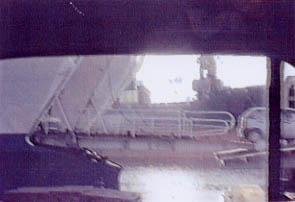
Before the ramp was
closed the splints were pulled out, the moveable parts were turned backwards
and secured again by the splints. The image below shows the closed bow ramp
from the inside.
Upon evaluation
of the video tapes by Disengage parts of the bow ramp rails were identified
on the sea bottom and the images shown below and overleaf were produced.
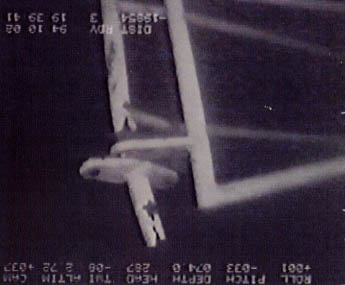
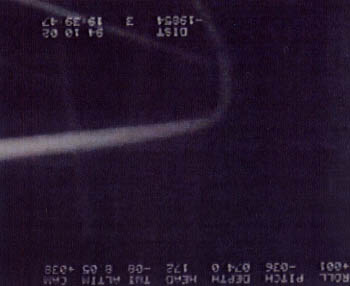
The two images above
made by ROV on 2.10.94 already clearly and without doubt prove that it is
the forward section with movable part of the starboard bow ramp rail which
is resting on the bottom of the sea.
A reconstruction
of the ROV track commencing at the stern of the wreck revealed that these
rail parts are located about 250 m to the south of the stern and about 80
m to the south-east of an area where the video was cut three times, each time
for about 1 minute.
For further
details see Subchapter 29.2 - The Bow Area.
The following images
show the remains of the clearly cut off 2nd and 3rd stanchions from forward
of the port bow ramp rail. As can be seen the stanchion was located next to
the port upper mating box for the ramp securing bolt.
It is obvious that
this stanchion did not break off but was mechanically cut off. The image is
part of the diver video tape B40c of 03.12.94 which proves that the bow ramp
rail on both sides had disappeared. As it is difficult to believe that the
bow ramp should have had no rails without anyone - including the Swedish safety
inspectors - noting it in Tallinn, the rails must have been cut off subsequently,
i.e. after departure. For further details see Subchapter 29.2.
The preventer
wires attached at both sides of the bow ramp and the car deck opening
were installed to prevent the bow ramp's falling down onto the forepeak deck
in case of the failure of the ramp actuators, i.e. wires, shakles, lugs were
dimensioned to catch the falling ramp without breaking.
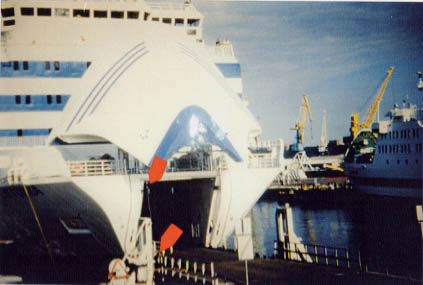
The arrows on the
picture above point to the shackles by which the starboard preventer wire
is connected to vessel and bow ramp. The system on the port side is identical.
The evaluation of
the available video footage by Disengage reveals that
(a) both preventer
wires were still attached by shackles to the lugs at the car deck opening;
(b) the port
wire cannot be seen in full length, it disappears behind the bow ramp;
(c) the starboard
wire, however, can be seen in full length as shown on the image below.

The shackle with
bolt is obviously attached to the lug of the wire in undamaged condition.
(d) Both lugs at
the ramp are intact and undamaged. The port lug is just slightly bent inwards
as is the upper mating pocket for the securing bolt.
For further details
see Subchapter 29.2. Also here the question arises who unshackled the preventer
wire and put the bolt back into the shackle and for what purpose and at what
time? As the above image was taken from the ROV video from 09.10.94 it is
obvious that the explained condition existed almost two months before the
official divers went down.
as to (7) The
angle iron in the housing of the port bow ramp actuator.
The image overleaf
from the diver video B40c shows the lower part of the opening of the housing
of the port bow ramp actuator. The broken lug of the actuator - by which it
had been connected to the bow ramp - can be seen. The actuator is in almost
retracted condition.

The following image
was produced from footage made when the diver looked into the actuator opening
more from the side. The image was enhanced by Disengage with special equipment
and it revealed that some strong steel piece was sticking behind the actuator.
Further analysis of this footage revealed that this was an angle iron (arrow
1) which had obviously at some stage been pressed into the adjacent bulkhead
plating (arrow 2) with the bulkhead port in between unaffected (arrow 3).
It was at first
assumed that this angle iron had been placed there to sabotage the complete
closing of the bow ramp, however on second thought it is more likely that
this steel piece had been placed there deliberately by the crew to prevent
the actuator fastening from hooking at the edge of the front bulkhead because
the ramp had been considerably hanging down with its port side due to the
broken port hinges which had destroyed the initial alignment of the actuator
fastenings in the vessel and at the ramp.
As a matter of fact
- as will be demonstrated in Chapter 29 - the bow ramp was detached from the
vessel at the port outer and inner hinges. Therefore the ramp was hanging
down at the port side with respective effect on the port actuator which was
hooking at and rubbing against the bulkhead in way of the lower edge of the
opening. To smoothen these contacts the angle iron was probably installed.
This was another
temporary repair of the damaged bow ramp - in addition to the steel put underneath
the bolt of the port outer hinge - done without the consent of the Classification
Society.
as to (8) The
condition of the starboard stern ramp.
The image below shows
the inside of the upper starboard stern ramp to be partly open. It was taken
from the ROV video dated 09.10.94. The arrow on the picture further down points
to the area in question. This fact will be explained in detail in Subchapter
29.7.
Neither the eight
items explained above nor the discovery of the fourth and fifth body on/near
the bridge is mentioned in the Report of the JAIC.
Another result of
the diving investigation was the apparent fact that the entire starboard bilge
strake area including the adjacent shell plating pointing up to car deck level
was accessible and could thus be inspected by divers and ROVs, which was done.
The results, as far as they are possible to achieve from the severely censored
"Mudline video", are outlined in Subchapter 29.5. The drawing below demonstrate
the condition of the wreck. They were taken from the Smit Tak Survey Report
dated 08.12.94 and attached as Enclosure
27.410.
Finally the parts
officially recovered from the wreck on behalf of the JAIC have to be mentioned:
- 1 visor hinge bushing
(steel bushing + bronze bushing + securing plate)
- all 3 lugs of the
Atlantic lock
- the bolt of the
Atlantic lock
- 1 broken lug of
the port inner ramp hinge
- 2 steel distance
rings from the port outer ramp hinge
- 1 EPIRB storage
case
- 1 GPS receiver
- 1 portable lifeboat
radio set
- 1 ship's bell
- several smaller
bits and pieces
After having measured
the bolt of the Atlantic lock Börje Stenström threw it back into the sea,
although according to his own scenario it was one of the most important pieces
of evidence. This will be explained in Subchapter 29.2.
Also the sensor
plate of the Atlantic lock and the electric cables of the sensors were cut
off by one diver, but instead of putting them into the net together with the
other objects brought to the surface, the diver threw both to the sea bottom
apparently upon instruction of the supervisor.
The other objects
recovered by the divers upon instructions of the police or other organisations
are unknown to the public.
